Unit 4 Everyday economics Starting out 课件(共25张,内嵌音视频) 2024-2025学年高二英语外研版(2019)选择性必修4
文档属性
| 名称 | Unit 4 Everyday economics Starting out 课件(共25张,内嵌音视频) 2024-2025学年高二英语外研版(2019)选择性必修4 |
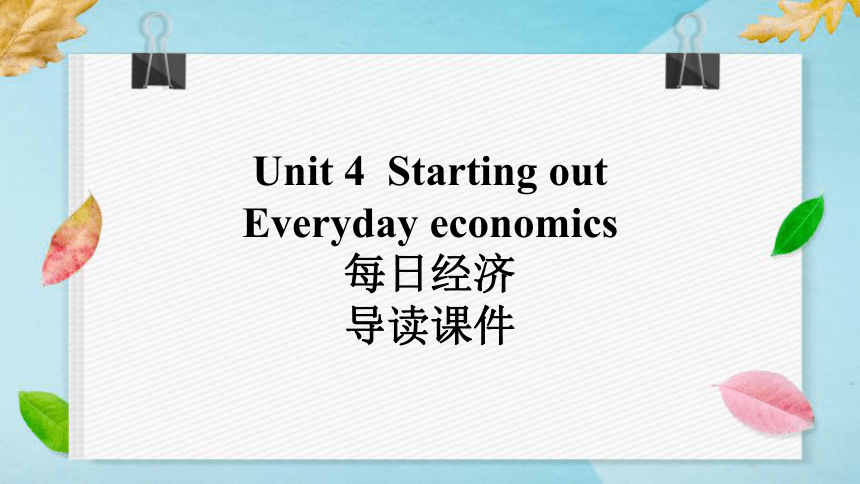
|
|
| 格式 | pptx | ||
| 文件大小 | 32.0MB | ||
| 资源类型 | 教案 | ||
| 版本资源 | 外研版(2019) | ||
| 科目 | 英语 | ||
| 更新时间 | 2025-04-23 16:14:30 | ||
图片预览



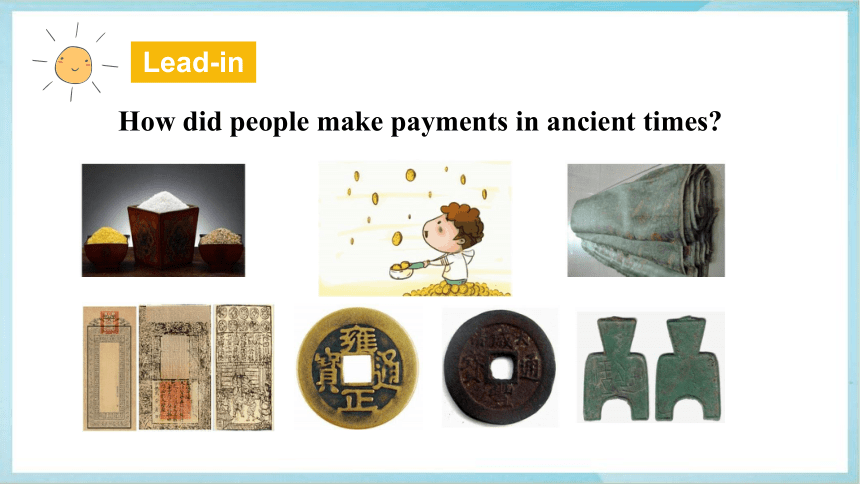

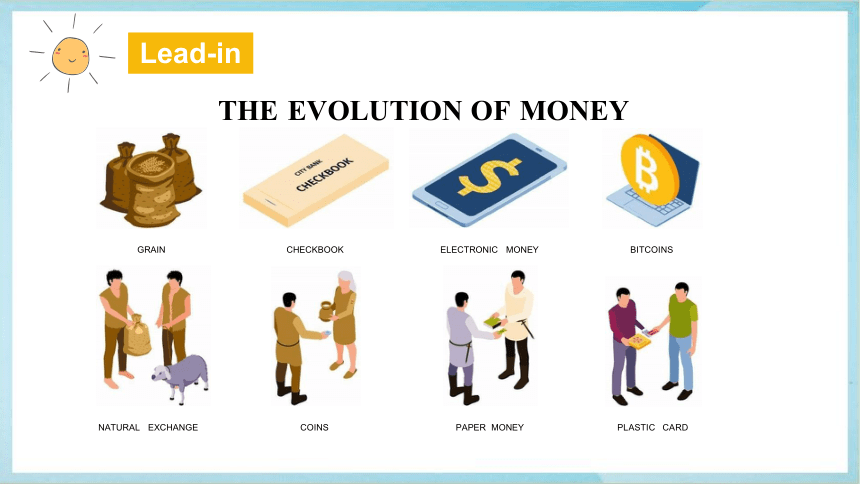
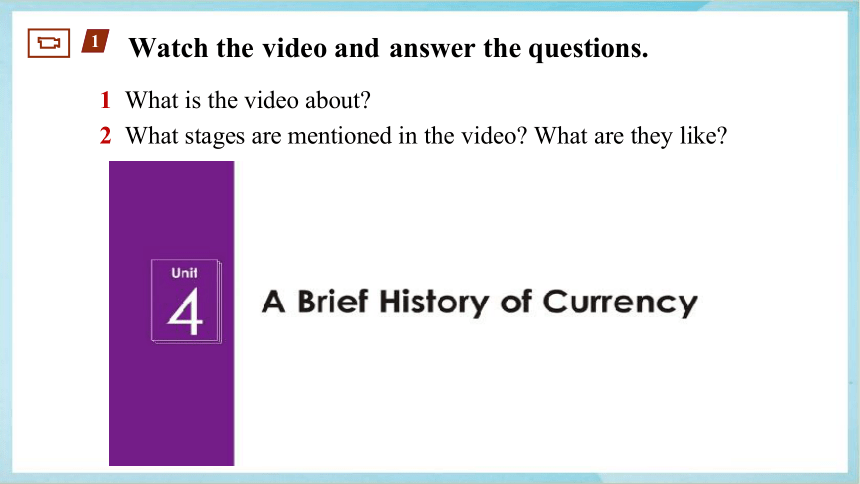
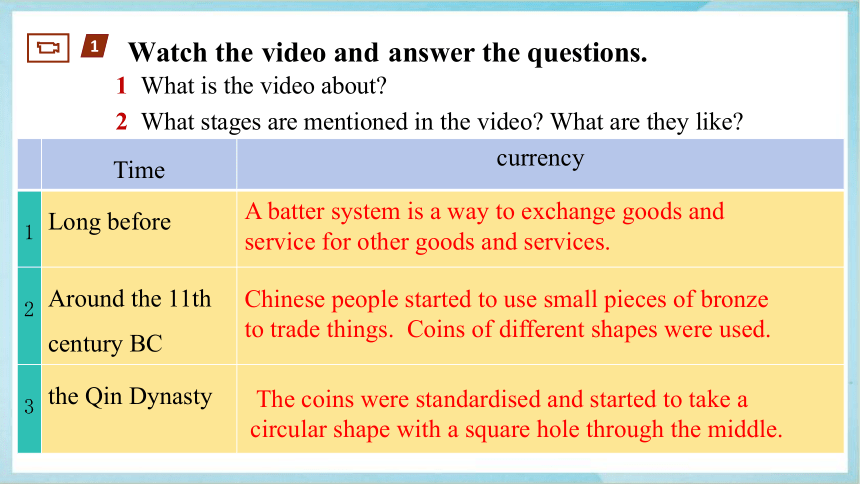
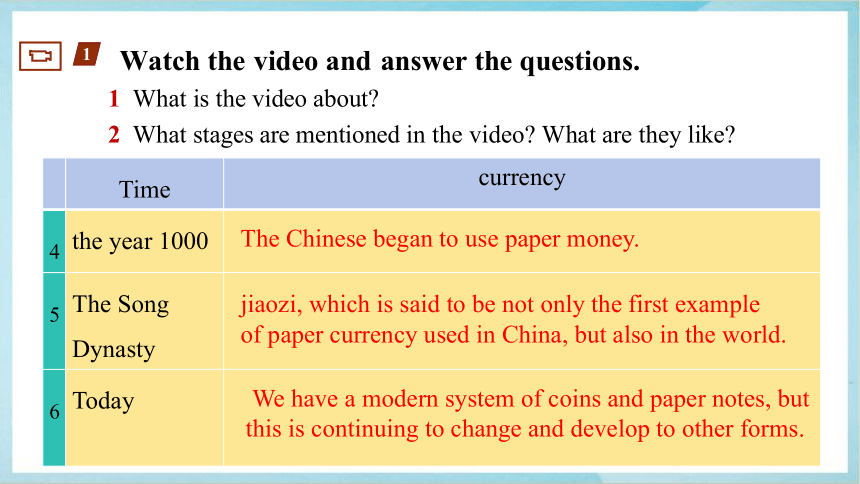
文档简介
(共25张PPT)
Unit 4 Starting out
Everyday economics
每日经济
导读课件
To talk about what you have known about different forms of currency;
To watch the video and get the main idea of the video;
To understand daily economic activities by looking at pictures;
To talk about the economic activities around you and your initial vision for the future of currency.
Learning objectives
forehead n. 额,前额 50
blank adj. 无表情的,木然的 50
dizzy adj. 头晕目眩的 50
chairwoman n. 女主席;女会长 50
* sunrise n. 日出(时分);黎明;拂晓 50
potential n. (事物的)潜力,可能性 51
* bug n. 突然的兴趣,迷恋 51
enterprising adj. 有创业精神的;有事业心的;有进取心的 51
input n. 投入(物) 51
* obstacle n. 障碍,阻碍,妨碍 52
Words and expressions
phase n. 阶段,时期 52
* manufacturer n. 制造商;制造公司,制造厂 52
* cosmetics n. 化妆品,美容品 52
purchase v. 购买 52
distribution n. (商品的)分销,经销 52
bonus n. 奖金;红利 52
* entrepreneurial adj. 创业的,具有创业精神的 52
guidance n. 指导,引导 52
consultant n. 顾问 52
How did people make payments in ancient times
Lead-in
How did people make payments in ancient times
Lead-in
THE EVOLUTION OF MONEY
NATURAL EXCHANGE COINS PAPER MONEY
GRAIN CHECKBOOK ELECTRONIC MONEY
PLASTIC CARD
BITCOINS
Lead-in
1
Watch the video and answer the questions.
1 What is the video about
2 What stages are mentioned in the video What are they like
1
Time currency
1 Long before
2 Around the 11th century BC
3 the Qin Dynasty
A batter system is a way to exchange goods and service for other goods and services.
Chinese people started to use small pieces of bronze to trade things. Coins of different shapes were used.
The coins were standardised and started to take a circular shape with a square hole through the middle.
Watch the video and answer the questions.
1 What is the video about
2 What stages are mentioned in the video What are they like
1
Time currency
4 the year 1000
5 The Song Dynasty
6 Today
The Chinese began to use paper money.
jiaozi, which is said to be not only the first example of paper currency used in China, but also in the world.
We have a modern system of coins and paper notes, but this is continuing to change and develop to other forms.
1 What is the video about
2 What stages are mentioned in the video What are they like
Watch the video and answer the questions.
视频脚本
A Brief History of Currency
Long before money was invented, people used a barter system to buy and sell things. A barter system is a way to exchange goods and services for other goods and services. For example, crops and animals might be traded for tools and clothing.
Later, some goods became more widely accepted than others for their utility. Gradually, they were used to calculate the value of other products and services. One such item was salt. During Roman times, soldiers were paid partly with salt for their work - and from this, we get the word “salary”.
As time went on, metal items were introduced into the trading system as money, since they were readily available. This made buying and selling easier, faster and fairer. The earliest metal coins came from China. Around the 11th century BC,Chinese people started to use small pieces of bronze to trade things. In the early stages, coins of different shapes were used. Today we can see in museums ancient money in the shape of knives or spades. The coins were standardised in the Qin Dynasty and started to take a circular shape with a square hole through the middle. This shape expressed ancient Chinese people's belief that the sky was round and the earth was square, and also their longing for a harmonious relationship with the universe.
Around the year 1000, the Chinese began to use paper money. The Song Dynasty saw the introduction of jiaozi. Jiaozi is said to be not only the first example of paper currency used in China, but also in the world. Paper money was easier to carry and could be taken to a bank and exchanged for metal money when needed. After visiting China in the 13th century, the explorer Marco Polo brought the concept of paper money back to Europe. Today, we have a modern system of coins and paper notes, but this is continuing to change and develop. As the use of physical money is on the decline, who knows what other forms of currency we will have at our fingertips in the future
视频脚本
货币简史
早在货币发明之前,人们就使用物物交换系统来买卖东西。物物交换系统是一种用商品和服务交换其他商品和服务的方式。例如,庄稼和动物可以用来交换工具和衣服。
后来,一些商品因其效用而比其他商品更被广泛接受。渐渐地,它们被用来计算其他产品和服务的价值。其中一项就是盐。在罗马时代,士兵的工资中有一部分是盐,由此我们就有了“薪水”这个词。
随着时间的推移,金属物品被作为货币引入交易系统,因为它们很容易获得。这使得买卖更容易、更快、更公平。最早的金属硬币来自中国。大约在公元前11世纪,中国人开始用小块的青铜来交换东西。在早期阶段,使用不同形状的硬币。今天我们可以在博物馆看到刀或黑桃形状的古代货币。秦朝时,硬币被标准化,开始呈圆形,中间有一个方孔。这个形状表达了中国古人天圆地方的信仰,也表达了他们对与宇宙和谐相处的渴望。
公元1000年左右,中国人开始使用纸币。宋朝出现了饺子。据说饺子不仅是中国,而且是世界上第一个使用纸币的例子。纸币更容易携带,需要时可以拿到银行兑换成金属货币。在13世纪访问中国后,探险家马可·波罗将纸币的概念带回了欧洲。今天,我们有一个现代的硬币和纸币系统,但这是继续变化和发展。随着实物货币的使用在减少,谁知道未来我们指尖上还会有什么其他形式的货币?
1
The video is about the development of currency.
(Just from the title of the video we can know it.)
1 What is the video about
Watch the video and answer the questions.
1
There are different stages in the development of currency.
Long before money was invented, people used a barter system to buy and sell things. A barter system is a way to exchange goods and services for other goods and services.
2 What stages are mentioned in the video What are they like
Watch the video and answer the questions.
Watch the video and answer the questions.
1
Later, some goods became more widely accepted than others. These could be used to calculate the value of other products and services. One such item was salt.
2 What stages are mentioned in the video What are they like
1
Around the 11th century BC, Chinese people started to use small piece of bronze to trade things. In the early stages, coins of different shapes were used. The coins were standardised in the Qin Dynasty and started to take a circular shape with a square hole through the middle.
Watch the video and answer the questions.
2 What stages are mentioned in the video What are they like
Watch the video and answer the questions.
1
Around the year 1000, the Chinese began to use paper money. The Song Dynasty saw the introduction of jiaozi, which is said to be not only the first example of paper currency used in China, but also in the world.
2 What stages are mentioned in the video What are they like
Watch the video and answer the questions.
1
Today, we have a modern system of coins and paper notes, but this is continuing to change and develop to other forms.
2 What stages are mentioned in the video What are they like
1 What activities are shown in the pictures
2 What do they have in common
3 What other economic activities are part of your daily life
Look at the pictures and answer the questions.
2
1 What activities are shown in the pictures
Look at the pictures and answer the questions.
2
The pictures show some daily activities, namely paying coins for some vegetables, using an ATM card, donating money to people in need, paying through an app on a smart phone.
2 What do they have in common
Look at the pictures and answer the questions.
2
These pictures all show types of economic behaviors, and they are all related to currency of various forms.
3 What other economic activities are part of your daily life
Look at the pictures and answer the questions.
2
I use my meal card to buy food or other school supplies and daily necessities at school every day and it is really very convenient for my campus life.
3 What other economic activities are part of your daily life
Look at the pictures and answer the questions.
2
Other activities like:
In-app Purchase,
including digital goods
or subscriptions
Online shopping
Look at the pictures and answer the questions.
2
Pictures What activities What they have in common
Donating money to people in need
Using an ATM card
Paying through an app on a smartphone
Paying coins for vegetables
The pictures show types of economic behaviors and they are related to currency of
various forms.
Search the Internet to find mobile payments around the world and predict how you think the world will develop in the future.
Homework
Possible version:
Mobile Payments Around the World and Future Trends
Mobile payments have become increasingly popular worldwide. In China, WeChat Pay and Alipay are widely used for everything from shopping to paying bills. In countries like Japan and South Korea, contactless payments via smartphones are also common.
In the West, Apple Pay, Google Wallet, and similar services are gaining traction. People can easily tap their phones to pay in stores or online.
Looking ahead, I believe mobile payments will continue to grow. As technology advances, cryptocurrencies and digital wallets may become more mainstream. Cash could gradually become less used as people embrace the convenience and security of digital payments. The future of money lies in
digital innovation.
Unit 4 Starting out
Everyday economics
每日经济
导读课件
To talk about what you have known about different forms of currency;
To watch the video and get the main idea of the video;
To understand daily economic activities by looking at pictures;
To talk about the economic activities around you and your initial vision for the future of currency.
Learning objectives
forehead n. 额,前额 50
blank adj. 无表情的,木然的 50
dizzy adj. 头晕目眩的 50
chairwoman n. 女主席;女会长 50
* sunrise n. 日出(时分);黎明;拂晓 50
potential n. (事物的)潜力,可能性 51
* bug n. 突然的兴趣,迷恋 51
enterprising adj. 有创业精神的;有事业心的;有进取心的 51
input n. 投入(物) 51
* obstacle n. 障碍,阻碍,妨碍 52
Words and expressions
phase n. 阶段,时期 52
* manufacturer n. 制造商;制造公司,制造厂 52
* cosmetics n. 化妆品,美容品 52
purchase v. 购买 52
distribution n. (商品的)分销,经销 52
bonus n. 奖金;红利 52
* entrepreneurial adj. 创业的,具有创业精神的 52
guidance n. 指导,引导 52
consultant n. 顾问 52
How did people make payments in ancient times
Lead-in
How did people make payments in ancient times
Lead-in
THE EVOLUTION OF MONEY
NATURAL EXCHANGE COINS PAPER MONEY
GRAIN CHECKBOOK ELECTRONIC MONEY
PLASTIC CARD
BITCOINS
Lead-in
1
Watch the video and answer the questions.
1 What is the video about
2 What stages are mentioned in the video What are they like
1
Time currency
1 Long before
2 Around the 11th century BC
3 the Qin Dynasty
A batter system is a way to exchange goods and service for other goods and services.
Chinese people started to use small pieces of bronze to trade things. Coins of different shapes were used.
The coins were standardised and started to take a circular shape with a square hole through the middle.
Watch the video and answer the questions.
1 What is the video about
2 What stages are mentioned in the video What are they like
1
Time currency
4 the year 1000
5 The Song Dynasty
6 Today
The Chinese began to use paper money.
jiaozi, which is said to be not only the first example of paper currency used in China, but also in the world.
We have a modern system of coins and paper notes, but this is continuing to change and develop to other forms.
1 What is the video about
2 What stages are mentioned in the video What are they like
Watch the video and answer the questions.
视频脚本
A Brief History of Currency
Long before money was invented, people used a barter system to buy and sell things. A barter system is a way to exchange goods and services for other goods and services. For example, crops and animals might be traded for tools and clothing.
Later, some goods became more widely accepted than others for their utility. Gradually, they were used to calculate the value of other products and services. One such item was salt. During Roman times, soldiers were paid partly with salt for their work - and from this, we get the word “salary”.
As time went on, metal items were introduced into the trading system as money, since they were readily available. This made buying and selling easier, faster and fairer. The earliest metal coins came from China. Around the 11th century BC,Chinese people started to use small pieces of bronze to trade things. In the early stages, coins of different shapes were used. Today we can see in museums ancient money in the shape of knives or spades. The coins were standardised in the Qin Dynasty and started to take a circular shape with a square hole through the middle. This shape expressed ancient Chinese people's belief that the sky was round and the earth was square, and also their longing for a harmonious relationship with the universe.
Around the year 1000, the Chinese began to use paper money. The Song Dynasty saw the introduction of jiaozi. Jiaozi is said to be not only the first example of paper currency used in China, but also in the world. Paper money was easier to carry and could be taken to a bank and exchanged for metal money when needed. After visiting China in the 13th century, the explorer Marco Polo brought the concept of paper money back to Europe. Today, we have a modern system of coins and paper notes, but this is continuing to change and develop. As the use of physical money is on the decline, who knows what other forms of currency we will have at our fingertips in the future
视频脚本
货币简史
早在货币发明之前,人们就使用物物交换系统来买卖东西。物物交换系统是一种用商品和服务交换其他商品和服务的方式。例如,庄稼和动物可以用来交换工具和衣服。
后来,一些商品因其效用而比其他商品更被广泛接受。渐渐地,它们被用来计算其他产品和服务的价值。其中一项就是盐。在罗马时代,士兵的工资中有一部分是盐,由此我们就有了“薪水”这个词。
随着时间的推移,金属物品被作为货币引入交易系统,因为它们很容易获得。这使得买卖更容易、更快、更公平。最早的金属硬币来自中国。大约在公元前11世纪,中国人开始用小块的青铜来交换东西。在早期阶段,使用不同形状的硬币。今天我们可以在博物馆看到刀或黑桃形状的古代货币。秦朝时,硬币被标准化,开始呈圆形,中间有一个方孔。这个形状表达了中国古人天圆地方的信仰,也表达了他们对与宇宙和谐相处的渴望。
公元1000年左右,中国人开始使用纸币。宋朝出现了饺子。据说饺子不仅是中国,而且是世界上第一个使用纸币的例子。纸币更容易携带,需要时可以拿到银行兑换成金属货币。在13世纪访问中国后,探险家马可·波罗将纸币的概念带回了欧洲。今天,我们有一个现代的硬币和纸币系统,但这是继续变化和发展。随着实物货币的使用在减少,谁知道未来我们指尖上还会有什么其他形式的货币?
1
The video is about the development of currency.
(Just from the title of the video we can know it.)
1 What is the video about
Watch the video and answer the questions.
1
There are different stages in the development of currency.
Long before money was invented, people used a barter system to buy and sell things. A barter system is a way to exchange goods and services for other goods and services.
2 What stages are mentioned in the video What are they like
Watch the video and answer the questions.
Watch the video and answer the questions.
1
Later, some goods became more widely accepted than others. These could be used to calculate the value of other products and services. One such item was salt.
2 What stages are mentioned in the video What are they like
1
Around the 11th century BC, Chinese people started to use small piece of bronze to trade things. In the early stages, coins of different shapes were used. The coins were standardised in the Qin Dynasty and started to take a circular shape with a square hole through the middle.
Watch the video and answer the questions.
2 What stages are mentioned in the video What are they like
Watch the video and answer the questions.
1
Around the year 1000, the Chinese began to use paper money. The Song Dynasty saw the introduction of jiaozi, which is said to be not only the first example of paper currency used in China, but also in the world.
2 What stages are mentioned in the video What are they like
Watch the video and answer the questions.
1
Today, we have a modern system of coins and paper notes, but this is continuing to change and develop to other forms.
2 What stages are mentioned in the video What are they like
1 What activities are shown in the pictures
2 What do they have in common
3 What other economic activities are part of your daily life
Look at the pictures and answer the questions.
2
1 What activities are shown in the pictures
Look at the pictures and answer the questions.
2
The pictures show some daily activities, namely paying coins for some vegetables, using an ATM card, donating money to people in need, paying through an app on a smart phone.
2 What do they have in common
Look at the pictures and answer the questions.
2
These pictures all show types of economic behaviors, and they are all related to currency of various forms.
3 What other economic activities are part of your daily life
Look at the pictures and answer the questions.
2
I use my meal card to buy food or other school supplies and daily necessities at school every day and it is really very convenient for my campus life.
3 What other economic activities are part of your daily life
Look at the pictures and answer the questions.
2
Other activities like:
In-app Purchase,
including digital goods
or subscriptions
Online shopping
Look at the pictures and answer the questions.
2
Pictures What activities What they have in common
Donating money to people in need
Using an ATM card
Paying through an app on a smartphone
Paying coins for vegetables
The pictures show types of economic behaviors and they are related to currency of
various forms.
Search the Internet to find mobile payments around the world and predict how you think the world will develop in the future.
Homework
Possible version:
Mobile Payments Around the World and Future Trends
Mobile payments have become increasingly popular worldwide. In China, WeChat Pay and Alipay are widely used for everything from shopping to paying bills. In countries like Japan and South Korea, contactless payments via smartphones are also common.
In the West, Apple Pay, Google Wallet, and similar services are gaining traction. People can easily tap their phones to pay in stores or online.
Looking ahead, I believe mobile payments will continue to grow. As technology advances, cryptocurrencies and digital wallets may become more mainstream. Cash could gradually become less used as people embrace the convenience and security of digital payments. The future of money lies in
digital innovation.
